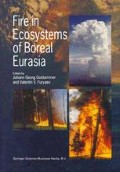Abstract
It is now widely recognized that the forests of the Angara region, as they look today, developed essentially under the influence of fires (Popov 1957, 1982; Krauklis 1975, 1985; Buzykin and Popova 1978). Fires are a common disturbance event and an important ecological factor in taiga forests. Over the last few decades, spatial patterns of forest communities, at different stages of post-fire succession, are undergoing complicated changes due to increasing forest resource exploitation. Intensive forest harvesting leads to a great increase of areas occupied by young stands. In most parts of the Angara region, fires and cutting cause the replacement of climax dark conifers by light coniferous and hardwood species. Relatively frequent surface fires destroy dark conifer regrowth and the subordinate (lower) wood layer composed of spruce, fir, and Pinus sibirica, thereby hamper their regeneration. Wide local variations in age structure, species composition, and productivity of southern taiga forests of the Angara region are attributed to the heterogenity of ecological site conditions and different patterns of fire occurrence and harvesting, which in turn determine specific microclimatic situations. Since regeneration processes after human-caused disturbances in fact obey, the same laws as natural vegetation succession, it is reasonable to study post-fire and post-cutting vegetation successions in the context of general vegetation cover dynamics.
Access this chapter
Tax calculation will be finalised at checkout
Purchases are for personal use only
Preview
Unable to display preview. Download preview PDF.
References
Alexandrova, V.D. 1964. Vegetation cover dynamics. Field Geobotanical Investigations (Polevaya geobotanika) Vol.3, 300–450. Moscow-Leningrad <in Russian>.
Armand, A.D., and G.V. Kushnareva 1989. Ecosystems overcoming their critical state in space. In: Ecosystems in Critical State (Ekosistemy v kriticheskom sostoyanii), 75–82. Nauka Publ., Moscow <in Russian>.
Buzykin, A.I., and E.P. Popova. 1978. The influence of fires on forest phytocoenoses and soil properties. In: Pine Forest Productivity (Produktivnost sosnovykh lesov), 5–45. Nauka Publ., Novosibirsk <in Russian>.
Chambless, L.F., and E.S. Nixon. 1975. Woody vegetation-soil relations in a bottomland forest of East Texas. Texas J. Sci. 26, 407–416.
Dyrenkov, S.A. 1984. Taiga spruce forest structure and dynamics. Nauka Publ., Leningrad. 173 pp. <in Russian>.
Filrose, E.M., A.E. Riabchinsky, G.M. Galushko, and A.V. Konashov. 1990. Ecology of Forests of Western Bashkiria. Ural Branch of the USSR Acad. Sci. Sverdlovsk. 180 pp. <in Russian>.
Kopp, D., und W. Schwanecke. 1972. Zur Methodenwahl für großmaßstäbige forstliche Standortskartierungen. Beitr. Forstwirt. 6 (2), 4–10.
Krauklis, A.A. 1975. Specific features of the taiga forest of Angara region. In: Natural Regimes and Topogeosystems of Taiga Forest in Angara Region (Prirodnye rezhimy i topogeosistemy Priangarskoi taigi), 14–27. Nauka Publ., Novosibirsk <in Russian>.
Krauklis, A.A. 1985. Area analysis on a regional scale. In: Ecosystem Dynamics and Forest Resource Exploitation in Angara Region (Dinamika ekosistem i osvoyenie priangarskoi taigi), 6–72. Nauka Publ., Novosibirsk <in Russian> .
Krutko, V.N., S.A. Pegov, D.M. Khomyakov, and P.M. Khomyakov. 1982. Formalization of qualitative estimates of environmental components. All-Union Institute for System Investigation. Moscow <in Russian>.
Layser, E.F. 1974. Vegetative classification. It’s application to forestry in the northern Rocky Mountains. J. For. 72, 354–357.
Lopatin, V.D. 1972. Using similarity coefficient equation in the analysis of grass cover development in meadows and in calculating the rate of syngenesis. In: Methods of Quantitative Estimation in the Investigation of Phytocoenoses Structure (Primenenie kolichestvennykh metodov pri izuchenii struktury fitocenozov), 76–83. Nauka Publ., Moscow <in Russian>.
Manko, Yu.I. 1989. Classification of dark coniferous forests of the Far East. In: Dynamic Forest Typology (Dinamicheskaya tipologia lesa), pp.72–80. Nauka Publ., Moscow <in Russian>.
Popov, L.V. 1957. Forests of Chuna-Vikhoreva interfluve. In: Biology Series, Transactions of East-Siberian Branch of the USSR Acad. Sci. Vol. 5, 144 pp. <in Russian>.
Popov L.V. 1982. Southern taiga forests of Central Siberia. Irkutsk State University Publ., Irkutsk, 360 pp. <in Russian>.
Ramensky, L.G, I.A. Tzatzenkin, O.I. Chizhikov, and N.A. Antipin. 1956. Ecological assessment of natural meadowlands using vegetation cover analysis. Moscow. 472 pp. <in Russian>.
Vasilevich, V.I. 1969. Statistical methods in geobotany. Nauka Publ., Leningrad. 232 pp. <in Russian>.
Vinogradov, B.V. 1984. Aero-space ecosystem monitoring. Nauka Publ., Moscow. 321 pp. <in Russian>.
Author information
Authors and Affiliations
Editor information
Editors and Affiliations
Rights and permissions
Copyright information
© 1996 Springer Science+Business Media Dordrecht
About this chapter
Cite this chapter
Pleshikov, F.I., Ryzhkova, V.A. (1996). Ecological Estimation of Forest Succession Patterns in Central Angara Region. In: Goldammer, J.G., Furyaev, V.V. (eds) Fire in Ecosystems of Boreal Eurasia. Forestry Sciences, vol 48. Springer, Dordrecht. https://doi.org/10.1007/978-94-015-8737-2_35
Download citation
DOI: https://doi.org/10.1007/978-94-015-8737-2_35
Publisher Name: Springer, Dordrecht
Print ISBN: 978-90-481-4725-0
Online ISBN: 978-94-015-8737-2
eBook Packages: Springer Book Archive

